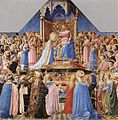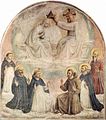Coronation of the Virgin
The Coronation of the Virgin Mary in Heaven | |
|---|---|
Roman Catholic Church | |
| Feast | May 31st (until 1968) August 22nd (present) |
| Attributes | Mary crowned in Heaven by Jesus or jointly with God the Father, surrounded by Cherubim and/or Saints |
The Coronation of the Virgin or Coronation of Mary is a subject in
The subject became common as part of a general increase in devotion to Mary in the Early
Official status and feast
The belief in Mary as Queen of Heaven obtained the papal sanction of Pope Pius XII in his encyclical Ad Caeli Reginam (English: 'Queenship of Mary in Heaven') of October 11, 1954.[1]
The
The act of the Virgin Mother of God being physically crowned as Queen of Heaven and Earth after her Assumption is a traditional Catholic belief echoed in the Rosary. The Coronation of the Blessed Virgin Mary is the fifth of the Glorious Mysteries of the Rosary.[2]
The Coronation of the Blessed Virgin is also a subject of devotion throughout Christianity. Beyond art, the Coronation is a central motif in Marian
Origin
The scene is the final episode in the
The subject also drew from the idea of the Virgin as the “Throne of
The subject seems to first appear in art, unusually, in England, where f. 102v in the
There are three examples extant on Devon rood screen dados: at East Portlemouth, Holne, and Torbryan.
Composition
In earlier versions, Mary and Christ often sit side-by-side on a wide throne, and typically are only accompanied by angels in smaller altarpieces, although these were often in polyptych form, and had saints on side-panels, now often separated. Later, God the Father often sits to the left of Christ, with the Holy Spirit hovering between them, and Mary kneeling in front and below them. Christ and the Father are normally differentiated by age, and to some extent by costume: God the Father is often wearing a beehive-shaped crown, reminiscent of a Papal tiara.
By the 15th century, more individual interpretations are found. From the High Renaissance onwards, the subject is often combined with an Assumption as a group of Apostles is on the earthly space below the heavenly scene, sometimes with Mary's empty tomb. As the central panel of altarpieces became larger until it abandoned the predella and side-panels, the Coronation was one subject suited to a very tall composition, especially if it had Apostles or other saints of importance to the community depicted on the lower sections.
Crown of Mary
The "crown" of Mary has been mentioned since the 6th century, as "corona virginum" (crown of virgins).
A crowned Mary is usually seen in
Individual works with articles
- Coronation of the Virgin (Beccafumi)
- Coronation of the Virgin (El Greco, Illescas)
- Coronation of the Virgin (Filippo Lippi), Uffizi
- Marsuppini Coronation by Filippo Lippi, Vatican Museums
- Coronation of the Virgin (Fra Angelico, Louvre)
- Coronation of the Virgin (Fra Angelico, Uffizi)
- Coronation of the Virgin (Gentile da Fabriano)
- Coronation of the Virgin (Lorenzo Monaco)
- Coronation of the Virgin with saints by Piero del Pollaiuolo in the church of Sant'Agostino, San Gimignano
- Coronation of the Virgin (Rubens), Hermitage Museum
- Coronation of the Virgin (Velázquez)
- Coronation of the Virgin Altarpiece by Moretto da Brescia
- Oddi Altarpiece, Raphael
- The Coronation of the Virgin by Enguerrand Quarton
Gallery
To 1500
-
Giuliano da Rimini, 14th century
-
Paolo Veneziano, 1324
-
Agnolo Gaddi, c. 1380
-
Martino di Bartolomeo, 1400
-
German altar, 1413-1422
-
Gentile da Fabriano, 1422-1425
-
Bicci di Lorenzo, 1430
-
Fra Angelico, Louvre with a larger court setting, 1430-1431
-
Fra Angelico, Uffizi, 1434-1435
-
Fra Angelico, 1437-1446
-
Filippo Lippi, 1441-1447
-
Giovanni di Paolo, 1455
-
German 15th-century version with donors, Master of the Life of the Virgin
-
Filippo Lippi (1467-1469); apse of the cathedral of Spoleto
-
Piero del Pollaiuolo, 1483
-
Botticelli, with only God the Father in evidence, 1490-1492
-
Michael Sittow, 1492-1496
-
Swedish 15th-century altarpiece in carved and painted wood (Källunge Church)
Unusual Trinities
-
Conventional depiction of the Trinity, with Christ showing the wounds of his Passion
-
Enguerrand Quarton with Christ and God the Father as identical figures, as specified by the cleric who commissioned the work
-
Page fromBook of Hours, with three human figures for the Trinity
-
depictions of Jesus
Post-1500
-
Albrecht Dürer combines the subject with an Assumption
-
Raphael, 1502-1504
-
Pietro Perugino, 1504
-
Ridolfo Ghirlandaio, 1504
-
El Greco 1591
-
El Greco, 1597
-
Giulio Cesare Procaccini, c. 1604-1607
-
Attributed to Amaro do Vale, c. 1615-1619
-
Banner of theIrish Catholic Confederation(1642–1652)
Post-1800
-
Domingos Sequeira, c. 1830
-
Stained glass window atSt. Michael's Cathedral (Toronto)depicts Coronation of the Virgin.
-
19th-century German altar
See also
- Marian art in the Catholic Church
- Blessed Virgin Mary
- Canonical Coronation
- Queen of Heaven
Notes
- ^ Pope Pius XII, Ad Caeli Reginam, 11 October 1954, Dicastero per la Comunicazione
- ^ "Glorious Mysteries", Vatican
- ^ a b Wright, 83
- ^ " The Coronation of the Virgin, 1324", National Gallery of Art
- ^ F Tschochner, Krone in Marienlexikon Eos St. Ottilien 1988, p.685
- ^ a b Tschochner 685
- ^ "Santa Maria in Trastevere – Rome, Italy". Living Mosaics. Mozaico.
References
- Wright, Rosemary Muir, Sacred Distance: Representing the Virgin Mary in Italian Altarpieces, 1300-1630, 2006, Manchester University Press, ISBN 9780719055454






























![Attributed to Amaro do Vale [pt], c. 1615-1619](http://upload.wikimedia.org/wikipedia/commons/thumb/8/8f/Coroa%C3%A7%C3%A3o_da_Virgem_%281615-19%29_-_Amaro_do_Vale_%28attrib.%29.png/120px-Coroa%C3%A7%C3%A3o_da_Virgem_%281615-19%29_-_Amaro_do_Vale_%28attrib.%29.png)




